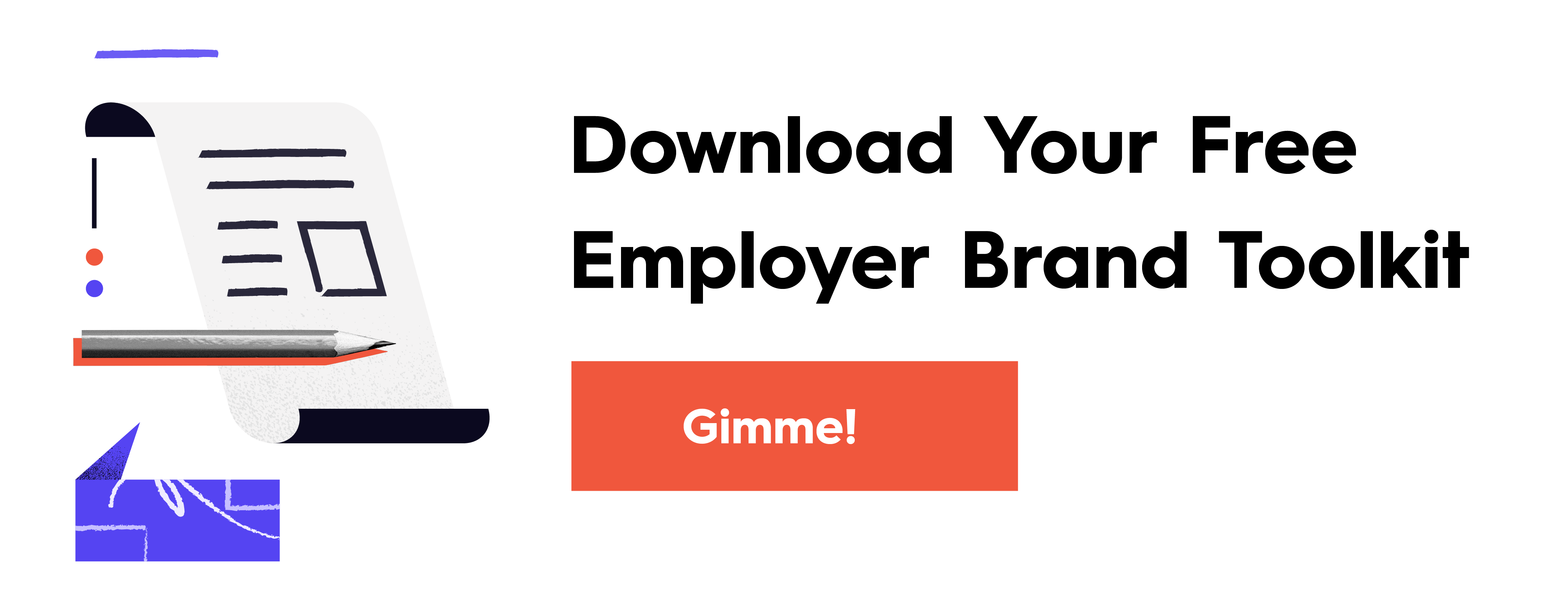Strong employer branding is about knowing who you are and, most importantly, communicating who you are at every brand touchpoint—in your values, actions, words, culture, etc. The better you can do this, the more you can attract the right kind of people to stay long-term, increase engagement, and more. The problem is that many brands don’t really know who they are. An employer brand is the composite of many people’s experiences and perceptions, so to get true perspective, you need to understand what the larger experience of working for your brand is like—from both inside and outside. How do you get that perspective? By doing an employer brand survey to audit your brand and identify how to improve.

Why Is an Employer Brand Audit Necessary?
Your employees are your brand’s lifeblood. They have agreed to spend 8+ hours a day with you, which is a commitment much greater than almost any product sale. Cultivating an environment where they feel valued is paramount. But you can’t just flip a switch and make that happen. Every brand has an idea of who they want to be. But just because you want to be perceived in a particular light doesn’t mean you actually will be.
And you certainly can’t fake it til you make it. Whereas customer brands can portray themselves in highly aspirational ways, the promises employer brands make are closely watched by powerful brand stakeholders—employees—and have little room for truth-stretching.

If you want employer branding, you need to follow through on your values and tell earnest and honest stories. Doing an employer brand audit is a helpful way to make this happen.
During an audit, you interview a range of employees to understand their experience of your employer brand. This objective look at your brand’s strengths and weaknesses helps you clarify what makes you special and what you need to improve. With these insights, you can work to nurture a healthy employer brand and, most importantly, represent your brand authentically and honestly.
That doesn’t mean this work is easy to do. Building a strong brand requires fearless self-inventory, a willingness to face criticism, and a commitment to create a happier workforce. But you don’t have to go it alone.
Here, we’ll walk you through the steps of an employee brand audit to help you get the information you need to create the brand you want.
Step 1: Identify Who You’re Going to Talk To
The entire point of this exercise is to get an honest perspective about your brand, both inside and outside the walls of your organization. The more people you talk to, the more understanding you’ll have. This means you need to look beyond the break room or the boardroom. Ideally, you should solicit the perspective of:
- Prospective candidates: These are the people who are interested in working at your company, or who might be interested in the future.
- Candidates: These are the people who are in the active application process or pipeline. You need the perspective of both prospective and current candidates to help you understand how you are currently marketing your employer brand, if it’s authentic, and if it’s effective.
- Current employees: No one knows your employer brand better than the people who are already working for you, so this group will be your richest source of information. Whether they’ve worked for you for 6 months or 15 years, they are your best gauge on whether or not your employer branding is truly aligned. Note: When you solicit feedback from current employees, make sure you’re talking to a healthy cross-section of your company, including different departments, leadership levels, genders, races, etc.
- Alumni: Former employees can be your best advocates or your worst nightmare. Often, this group is a major source of referrals for great talent, so you certainly want their input. Their opinions and experiences can tell you a lot about your strengths and weaknesses.
How do you reach these people? Luckily, you don’t have to host an hourlong in-person focus group with each sector. While you could do that in-house, tools like LinkedIn make it especially easy to send out a quick poll or touch base with prospective or former employees.
(Note: If you haven’t done one yet, you should also do a competitive analysis to understand how your competition attracts people.)
Step 2: Ask the Right Questions
Again, your goal here is to get a holistic look at your employer branding to understand your greatest strengths, weaknesses, and differentiators. To get these insights, though, you need to ask the right people the right questions.
To make this easier, we’ve created unique Google Form templates to help you survey prospective candidates, candidates, current employees, and alumni about your employer brand.
These templates include a basic set of survey questions tailored to each group. You can modify questions according to your needs, then use them to guide in-person conversations or send them out as an anonymous survey. Pro tip: People are more likely to participate if you make your survey easy to answer in 5 minutes or less.
FREE TEMPLATES
Note: These are public templates, so make a copy before you start editing.
If you’re looking for additional questions beyond what’s included in the survey, here are a few more to consider.
PROSPECTIVE & CURRENT CANDIDATES
- How did you learn about our company?
- What did you want to know about working with us that you didn’t find out through research or interviews?
- Which company values stand out to you most?
- What are your general perceptions about our brand?
- What did you think about our company before interacting with the team vs. after?
CURRENT EMPLOYEES
- What was your last job like? How does our company compare?
- What were your expectations of when you were a candidate vs. when you got hired?
- What do you think our biggest advantage is over the competition? What strengths should we continue to build on?
- If our brand were represented by a single person, what type of person would it be? What type of car would this person own? How would he or she dress? What would his or her hobbies be?
- Imagine you’re an undercover reporter being sent into the company to write a culture story. What would your headline be?
ALUMNI
- Did your job facilitate growth?
- What did you like least about your job?
- What do you miss about our company?
- What were your expectations of when you were a candidate vs. when you got hired?
- What do you think is our biggest advantage over the competition? What strengths should we continue to build on?
The Muse has an excellent resource including 34 questions to ask.
Step 3: Start Reaching Out
There is no one perfect way to solicit feedback. Ideally, you’d want some quality time to talk in person, but how you conduct your audit is up to you. If time, distance, or other factors prevent in-depth chats, you can still source valuable feedback with a little netnography (aka online research) through a number of avenues, such as:
- Internal data/feedback (e.g., exit interviews)
- Surveys (e.g., Glint, SurveyMonkey, or Google Forms)
- Emails
- Review sites (e.g., Glassdoor, Blind, etc.)
- Job search platforms (e.g., LinkedIn or Jobvite)
- Social network career pages
If you are able to directly talk to people, there are a few things you can do to elicit better insights.
- Make it a guided conversation. The more comfortable people feel, the more they’ll open up. Use the template questions to help guide the conversation, but ask follow-ups for more information.
- Be mindful of who’s in the room. People may be less honest if there is leadership in the room. Think of your dynamics when curating groups to talk to.
- Lean into criticism. If someone brings up a challenging or negative topic around your employer branding, don’t steer away. Give them the space to speak freely. Focus on the root cause of their dissatisfaction and how your brand can make changes to address it. Remember that your brand is not just about what you say but how people experience it.
- Debrief with fellow moderators. Starting with the second or third session, chat for 10 or 15 minutes with your co-facilitators. Take note of common themes you’re observing and adjust your questions list as needed to extract deeper or different information in your next session.
Also, take notes (or record the conversation) to review in case you have follow-up questions or want to talk about something more.
Step 4: Turn Insights into Actions
Now that you’ve done your data collecting, it’s time to put it to work. Comb through your feedback to spot the common themes in both strengths and weaknesses. Some helpful questions to ask:
- What do people enjoy most about your company? Do your job descriptions, social media, and web presence capture that?
- Based on what you’ve learned, how can you best position your brand to attract the right kind of talent?
- What is the most common complaint? Do your complaints all stem from the same core issues? How can you remedy them?
- What was unexpected feedback (good or bad)?
- Where have you over-promised and under-delivered? How can you turn these into stretch goals or brand aspirations?
- Do people’s experiences align with your values?
If you can’t find any common threads or consensus in feedback, you may need to talk to more people or go more in depth.
What to Do with Your Employer Branding Insights
Most importantly, don’t let your audit findings go to waste. There are plenty of steps you can take to turn this newfound knowledge into better employer branding.
- Write an Employee Value Proposition. Just like your brand value proposition, articulate what it is that makes your brand different and what benefits people will get when they work for you. To do this effectively, see our guide to writing your own EVP.
- Turn your culture into content. See our culture marketing 101 guide for more ideas to spotlight your employees, share your brand story, and show people why they might like to work for you.
- Strengthen your brand. Learn more about the keys to strong employer branding and how you can make good on your promises.
And if you need more help building your brand or telling your brand story in any way, use these tips to find a content agency or holler at us.





